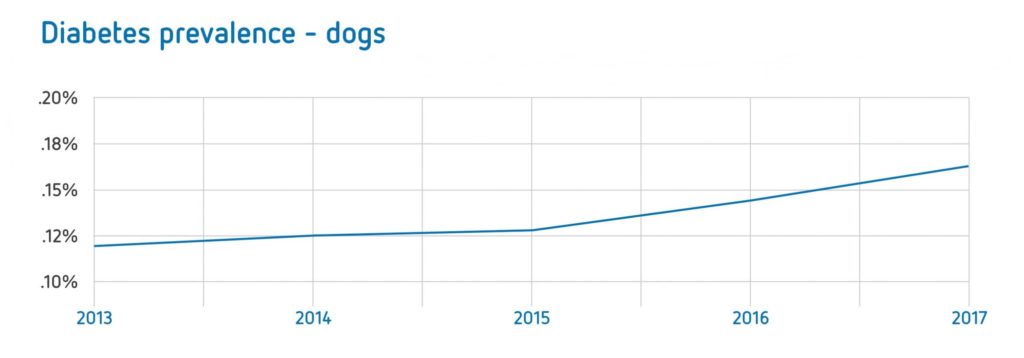The disease in dogs is most similar to the Type 1 Diabetes seen in children, where there is a lack of insulin produced in the body.
In the absence of insulin, the body’s fat and protein are broken down instead, resulting in muscle wasting and weight loss, despite the animal being ravenously hungry.
PetSure data shows the prevalence of Diabetes in Australian insured dogs in 2018 is 0.18%, which is slightly less than other international studies. Male dogs are slightly overrepresented for Diabetes in the PetSure data.

Possible causes
Implicating factors in Diabetes include chronic pancreatitis – a condition that results in the progressive destruction of the pancreas. Pancreatitis is usually associated with a high-fat diet and obesity. Close to 25% of PetSure insured dogs with Diabetes also have had a diagnosis of pancreatitis which is comparable with other studies.
Genetics also plays a role with some breeds reported to have a higher incidence of Diabetes, but this can also vary depending on geographic location. Some of the breeds more prone to Diabetes in Australia, according to PetSure, include the Poodle, Keeshond, Alaskan Malamute, Finnish Spitz, Miniature Schnauzer, Samoyed, Cairn Terrier, Bichon Frise, Tibetan Terrier, Pug, Yorkshire Terrier, Labrador Retriever and Australian Terrier. PetSure data is specific to Australian dogs.
Symptoms
Diabetes is more likely to be a disease of middle age to older dogs, and the incidence increases with age. Signs of Diabetes include weight loss, ravenous appetite, excessive drinking and urinating. Cataracts, lethargy and poor hair coat are also indicators of the disease.
Various diseases can co-exist with Diabetes in dogs, and the range of clinical signs reflect other concurrent conditions that are associated. Hyperadrenocorticism or Cushing’s Disease is a disease of excess glucocorticoid secretion in the body and is also commonly diagnosed in dogs with Diabetes, with a prevalence of close to 15% according to PetSure data. The excess cortisol results in increased glucose in the blood and insulin resistance in the body.
Treatment
Diabetes is diagnosed by vets based on clinical signs, physical examination and blood and urine tests checking for glucose levels. Persistently high glucose levels are the hallmark of the condition.
Treatment relies on daily or twice-daily injections of insulin, consistent feeding times and amounts, as well as regular exercise. Lifetime glucose monitoring is required for all dogs diagnosed with Diabetes and regular blood and urine tests are needed for long-term management.
Other concurrent diseases also need to be diagnosed and treated so that there is effective glucose control. The importance placed on a regular ‘routine’ is critical as one of the most dangerous aspects of diabetic treatment is the risk of low blood sugar in the body. This could be the result of either too much insulin given, too little food eaten or too much exercise.
If this occurs, dogs may just sleep a bit more, become lethargic or if severe hypoglycaemia occurs they may seizure or become unconscious, progressing to coma and death if left untreated.
Treatment for Diabetes is life-long as remission does not occur (which differs from cats).
Costs incurred for Diabetes in dogs are high at the time of diagnosis, where other diseases may also need to be diagnosed and treated. These costs accumulate yearly and while there is a variation in yearly costs per dog, it is mostly a treatable, manageable disease with many dogs going on to live healthy happy lives.
Pet insurance can help by covering a portion of the eligible vet bill if the unexpected happens. Because it is difficult to predict the costs of veterinary care, it can help to have measures in place to help prepare for the unexpected. Check out our partner network and explore our policy tools to find a pet insurance policy.
Not all conditions or items are covered by Pet Insurance. Refer to the applicable Product Disclosure Statement for information about coverage and exclusions.








